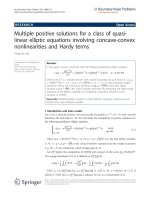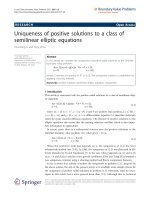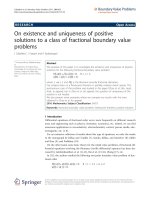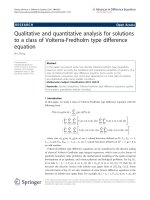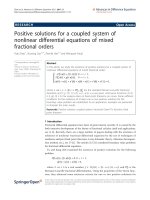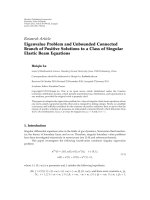UNIQUENESS OF POSITIVE SOLUTIONS OF A CLASS OF ODE WITH NONLINEAR BOUNDARY CONDITIONS RUYUN MA AND pdf
Bạn đang xem bản rút gọn của tài liệu. Xem và tải ngay bản đầy đủ của tài liệu tại đây (516.4 KB, 10 trang )
UNIQUENESS OF POSITIVE SOLUTIONS OF A CLASS OF ODE
WITH NONLINEAR BOUNDARY CONDITIONS
RUYUN MA AND YULIAN AN
Received 19 August 2004 and in revised form 27 January 2005
We study the uniqueness of positive solutions of the boundary value problem u
+ a(t)u
+ f (u) = 0, t ∈ (0,b), B
1
(u(0)) − u
(0) = 0, B
2
(u(b)) + u
(b) = 0, where 0 <b<∞, B
1
and
B
2
∈ C
1
(R), a ∈ C[0,∞)witha ≤ 0on[0,∞)and f ∈ C[0,∞) ∩ C
1
(0,∞) satisfy suitable
conditions. The proof of our main result is based upon the shooting method and the
Sturm comparison theorem.
1. Introduction
The existence of positive solutions of second order ordinary differential equations (ODEs)
with linear boundary conditions has been extensively studied in the literature, see Coff-
man [1], Henderson and Wang [7], Lan and Webb [8] and the references therein. Also the
existence of positive solutions of second order ODEs with nonlinear boundary conditions
has been studied by several authors, see Dunninger and Wang [2], Wang [11] and Wang
and Jiang [12] for some references along this line. However for the uniqueness problem of
second order ODEs, even in the linear boundary conditions case, very little was known,
see Ni and Nussbaum [9], Fu and Lin [6] and Peletier and Serrin [10]. To the best of our
knowledge, no uniqueness results of positive solutions were established for second order
ODEs subject to nonlinear boundary conditions. In this paper, we attempt to prove some
uniqueness results in this direction.
More precisely, we consider the uniqueness of positive solutions of the boundary value
problem
u
+ a(t)u
+ f (u) = 0, t ∈ (0,b) (1.1)
B
1
u(0)
− u
(0) = 0, B
2
u(b)
+ u
(b) = 0, (1.2)
where 0 <b<∞. We make the following assumptions:
(C1) f ∈ C[0, ∞) ∩ C
1
(0,∞)with f (0) = 0,
f (u) > 0, uf
(u) <f(u), for u>0; (1.3)
Copyright © 2006 Hindawi Publishing Corporation
Boundary Value Problems 2005:3 (2005) 289–298
DOI: 10.1155/BVP.2005.289
290 Uniqueness of positive s olutions of a class of ODE
(C2) a ∈ C[0,∞)witha(t) ≤ 0fort ≥ 0;
(C3) B
i
∈ C
1
[0,∞) satisfies B
i
(0) = 0, B
i
(x) > 0forx>0, B
i
(x)isnondecreasingon
(0,∞)(i = 1,2).
Remark 1.1. Condition (C3) implies that B
i
(x) ≥ 0forx ≥ 0(i = 1,2).
In fact, we have from B
i
(0) = 0andB
i
(x) > 0forx>0that
B
i
(0) ≥ 0. (1.4)
This together with the assumption B
i
(x) is nondecreasing on (0,∞) implies that B
i
(x) ≥ 0
for x ≥ 0.
The main result of this paper is the following.
Theorem 1.2. Let (C1)–(C3) hold. Then problem (1.1), (1.2) has at most one p ositive so-
lution.
Here we say u(t)isapositive solution of (1.1), (1.2), if that u(t) > 0on[0,b] and satisfies
the differential equation (1.1) as well as the boundary conditions (1.2).
Remark 1.3. As an application of Theorem 1.2, we consider the nonlinear problem
u
+ a(t)u
+ u
p
= 0, t ∈ (0,b),
u(0)
k
− u
(0) = 0,
u(b)
l
+ u
(b) = 0,
(1.5)
where p ∈ (0,1), k, l ∈ (1,∞)aregiven,a ∈ C[0, ∞)witha ≤ 0on[0,∞). Clearly all of
the conditions of Theorem 1.2 are satisfied. Therefore by Theorem 1.2,(1.5) has at most
a positive for any b ∈ (0,∞).
The proof of the main result i s motivated by the work of Erbe and Tang [3, 4, 5]andis
based on the shooting method and the Sturm comparison theorem. The rest of the paper
is organized as follows. In Section 2, we state and prove some preliminary lemmas. The
proof of Theorem 1.2 will be given in Section 3.
2. The preliminary results
To apply the shooting method, we need some properties of the solutions of the initial
value problem
u
+
¯
a(t)u
+
¯
f (u) = 0, (2.1)
u(0) = δ, u
(0) = λ. (2.2)
Lemma 2.1. Let
¯
a ∈ C[0, ∞),
¯
f ∈ C[0,∞) ∩ C
1
(0,∞) with
¯
f (0) = 0 and
¯
f (s) > 0 for s>0.
Let δ ∈ (0,∞) and λ ∈ R be two given constants. Then (2.1), (2.2)hasauniquesolutionu
satisfying either
(I) u(t) > 0 for t ∈ [0,∞);or
(II) there exists ρ ∈ (0,∞) such that
u(t) > 0 on t ∈ [0, ρ), u(ρ) = 0, u
(ρ) < 0. (2.3)
R. Ma and Y. An 291
Proof. For any r ∈ (0, ∞), let
Ω
r
:=
(t,u, p) | t ∈ [0,r], u>0
. (2.4)
Then the function
F(t,u, p):=
¯
a(t)p +
¯
f (u) (2.5)
satisfies local ly Lipschitz condition in Ω
r
, and consequently (2.1), (2.2) has a unique so-
lution u(t) such that one of the following cases must occur
(i) u>0on[0,∞);
(ii) there exists ρ ∈ (0,∞)suchthatu>0on[0,ρ), and lim
t→ρ
−
u(t) = 0;
(iii) there exists T ∈ (0,∞)suchthatu>0on[0,T)andlimsup
t→T
−
u(t) =∞.
We claim that (iii) can not occur.
Assume on the contrary that (iii) occurs, then
limsup
t→T
−
u
(t) =∞. (2.6)
On the other hand, we have from (2.1)that
u
(t)exp
t
0
¯
a(s)ds
+exp
t
0
¯
a(s)ds
¯
f (u) = 0, t ∈ [0,T) (2.7)
which together with the condition
¯
f (s) > 0fors>0 implies that
u
(t)exp
t
0
¯
a(s)ds
is strictly decreasing on [0,T). (2.8)
However this contradicts the fact (2.6).
Therefore either (i) or (ii) must occur.
Suppose on the contrary that (ii) occurs and u
(ρ) = 0. Using the similar argument of
proving (2.8), we conclude that u
(t)exp(
t
0
¯
a(s)ds) is strictly decreasing on [0,ρ). Thus
u
(t)exp(
t
0
¯
a(s)ds) > 0on[0,ρ), and accordingly u
(t) > 0on[0,ρ). However this contra-
dicts the fact δ = u(0) >u(ρ) = 0. Therefore u
(ρ) < 0 if (ii) occurs. This completes the
proof.
In order to prove Theorem 1.2, we introduce an initial value problem
u
+ a(t)u
+ f (u) = 0, (2.9)
u(0) = α>0, u
(0) = B
1
(α). (2.10)
For any α>0, we know from Lemma 2.1 that (2.9), (2.10) has a u nique solution u such
that one of the cases occurs:
(i) u>0in[0,
∞);
(ii) there exists a unique ρ = ρ(α) ∈ (0,∞)suchthatu(t) > 0on[0,ρ), u(ρ) = 0and
u
(ρ) < 0.
292 Uniqueness of positive s olutions of a class of ODE
Let
T
α
=
∞
, if (i) occurs
ρ(α), if (ii) occurs.
(2.11)
From α>0, we have that u(0,α) = α>0andu
(0,α) = B
1
(α) > 0, and consequently
B
2
u(0,α)
+ u
(0,α) = B
2
(α)+B
1
(α) > 0. (2.12)
Therefore, there exists ∈ (0, T
α
)suchthat
B
2
u(t,α)
+ u
(t,α) > 0, t ∈ [0,). (2.13)
Denote
B(t,α):= B
2
u(t,α)
+ u
(t,α). (2.14)
When B(t,α) vanishes at some t
0
∈ (0,T
α
), we define b(α)tobethefirstzeroofB(t,α)in
(0,T
α
). More precisely, b(α)isafunctionofα which has the properties
B
b(α),α
=
0, B(t, α) > 0, t ∈
0, b(α)
. (2.15)
If B(t,α)ispositivein[0,T
α
), then we define b(α) = T
α
.Let
N :=
α | α>0, b(α) <T
α
. (2.16)
It is obvious that (1.1), (1.2) has no positive solution if N is an empt y set. (We recall that
u is a positive solution means u(t) > 0in[0,b]. So in the case B(T
α
,α) = 0, u(t,α)isnota
positive solution of (1.1), (1.2) since u(T
α
,α) = 0). Hence we suppose N =∅.
Remark 2.2. It is worth remarking here that if (ii) occurs, and accordingly u(ρ(α),α) = 0,
then b(α) ∈ (0,ρ(α)),
B
b(α),α
=
0, B(t, α) > 0on
0,b(α)
. (2.17)
In fact, we have from Lemma 2.1 that
B
ρ(α),α
=
B
2
u(ρ,α)
+ u
ρ(α),α
< 0, (2.18)
which together with the fact B(0,α) > 0 yields the existence of zero of B(t,α)in(0,ρ(α)).
Lemma 2.3. Let (C1)–(C3) hold and let α ∈ N.Letu(t,α) be the unique solution of (2.9),
(2.10)on[0,T
α
). Then
u(t,α) > 0, t ∈
0,b(α)
,
u
b(α),α
< 0.
(2.19)
Proof. By Remark 2.2, b(α) ∈ (0,ρ(α)). Applying Lemma 2.1,wegetthat
u(t,α) > 0, t ∈
0,b(α)
. (2.20)
R. Ma and Y. An 293
Thesecondinequalityin(2.19) can be easily deduced from (2.20) and (C3) and the fact
B
b(α),α
= B
2
u
b(α),α
+ u
b(α),α
= 0. (2.21)
Lemma 2.4. Let (C1)–(C3) hold. Let u(t,α) be the unique solution of (2.9), (2.10)
on [0,T
α
).Ifη ∈ (0,T
α
) is such that
B(η,α) = 0, (2.22)
then
B(t,α) > 0, t ∈ [0,η). (2.23)
Proof. From (2.9), we conclude that
u
exp
t
0
a(s)ds
+exp
t
0
a(s)ds
f (u) = 0. (2.24)
Since u(t,α) > 0forallt ∈ [0,η], we have
u
(t,α)exp
t
0
a(s)ds
=−exp
t
0
a(s)ds
f
u(t,α)
< 0, ∀t ∈ [0,η]. (2.25)
Suppose on the contr ary that there exists τ
2
∈ [0,η)suchthat
B
τ
2
,α
=
B
2
u
τ
2
,α
+ u
τ
2
,α
=
0. (2.26)
Then we have from condition (C3) and the fact u(τ
2
,α) > 0that
u
τ
2
,α
=−
B
2
u
τ
2
,α
< 0 (2.27)
and accordingly
u
τ
2
,α
exp
τ
2
0
a(s)ds
< 0. (2.28)
This together with (2.25) implies that
u
(t,α)exp
t
0
a(s)ds
< 0, t ∈
τ
2
,η
, (2.29)
and consequently
u
(t,α) < 0, t ∈
τ
2
,η
. (2.30)
This implies
u
τ
2
,α
>u(η, α). (2.31)
294 Uniqueness of positive s olutions of a class of ODE
By Remark 1.1 and (2.31), we get
B
2
u
τ
2
,α
≥ B
2
u(η,α)
. (2.32)
From (2.30) and (C1)–(C2) and the fact u
(t,α) =−a(t)u
(t,α) − f (u(t,α)), it follows
that
u
(t,α) < 0, t ∈
τ
2
,η
(2.33)
and consequently
u
τ
2
,α
>u
(η,α), (2.34)
which together with (2.32) implies that
B
τ
2
,α
= B
2
u
τ
2
,α
+ u
τ
2
,α
>B
2
u(η,α)
+ u
(η,α) = 0. (2.35)
However this contradicts (2.26).
Remark 2.5. From Lemmas 2.3 and 2.4,wehavethatifη ∈ (0,T
α
) satisfies
B(η,α) = 0. (2.36)
Then
η = b(α). (2.37)
In other words, if α ∈ N,thenb(α) is the unique zero of B(t,α) = 0in[0,ρ(α)). Therefore
toprovethat(1.1), (1.2) has at most one positive solution, it is sufficient to show that for
any l>0, there exists at most one α ∈ N such that b(α) = l.
Now we denote the variation of u(t,α)byφ(t,α) = ∂u(t, α)/∂α.Then,φ(t,α) satisfies
φ
+ a(t)φ
+ f
(u)φ = 0, (2.38)
φ(0,α) = 1, φ
(0,α) = B
1
(α). (2.39)
Lemma 2.6. Suppose that
B
2
u
b(α),α
φ
b(α),α
+ φ
b(α),α
= 0, α ∈ N. (2.40)
Then one of the following cases must occur
(i) N is an open interval;
(ii) N
= (0, j
1
) ∪ ( j
2
,∞) with 0 <j
1
<j
2
< +∞.Moreover,b
(α) > 0 for all (0, j
1
);
b
(α) < 0 for all ( j
2
,∞).
Proof. We firstly show that b(α) ∈ C
1
(N)andb
(α) = 0.
From Lemma 2.3, (C1)–(C2), we conclude that
u
b(α),α
=−a
b(α)
u
b(α),α
− f
u
b(α),α
< 0. (2.41)
R. Ma and Y. An 295
This together with
B
b(α),α
=
0 (2.42)
and (C3) and (2.19) implies that
∂
∂t
B(t,α)
t=b(α)
= B
2
u
b(α),α
u
b(α),α
+ u
b(α),α
< 0. (2.43)
So by Implicit Function theorem, b(α) is well-defined as a function of α in N and b(α) ∈
C
1
(N). Furthermore, it follows from (2.43)thatN is an open set.
Differentiating both sides of (2.42) with respect to α,weobtain
B
2
u
b(α),α
u
b(α),α)b
(α)+φ
b(α),α
+ u
b(α),α
b
(α)+φ
b(α),α
= 0,
(2.44)
that is,
B
2
u
b(α),α
u
b(α),α
+ u
b(α),α
b
(α)
+ B
2
u
b(α),α
φ
b(α),α
+ φ
b(α),α
= 0.
(2.45)
which together with (2.40) implies that
b
(α) = 0. (2.46)
Next we show that if
¯
α ∈ (0,∞) \ N is such that there is a sequence {α
n
}⊂N and
α
n
→
¯
α as n →∞,thenb(α
n
) → +∞.
Suppose on the contrary that b(α
n
) +∞, then there exists a subsequence of {b(α
n
)}
which converges to a limit number t
∗
. Without loss of generality, we may suppose that
b(α
n
) → t
∗
as n →∞, and consequently
B
t
∗
,
¯
α
=
lim
n→∞
B
b
α
n
,α
n
=
0. (2.47)
However this contradicts
¯
α/∈ N.
Finally we show that if N is not an open interval, then (ii) must occur.
Suppose J
1
= (j
0
, j
1
)andJ
2
= (j
2
, j
3
) are two distinct components of N with 0 <j
1
<
j
2
< ∞.Then
lim
α→ j
−
1
b(α) = lim
α→ j
+
2
b(α) = +∞. (2.48)
Since b(α) is strictly monotonic in each component of N,wehavethatb
(α) > 0inJ
1
,and
b
(α) < 0inJ
2
. Meanwhile
lim
α→ j
+
0
b(α) < +∞,lim
α→ j
−
3
b(α) < +∞. (2.49)
It follows that j
0
= 0andj
3
= +∞,andaccordinglyN = (0, j
1
) ∪ ( j
2
,∞)withb
(α) > 0in
(0, j
1
), and b
(α) < 0in(j
2
,∞).
296 Uniqueness of positive s olutions of a class of ODE
3. Proof of Theorem 1.2
By Remark 2.5, we only need to show that for any l>0, there exists at most one α ∈ N
such that b(α) = l.
Recall that for any given α ∈ N,(2.43), (2.45) hold. If we can show that
B
2
u
b(α),α
φ
b(α),α
+ φ
b(α),α
> 0, α ∈ N (3.1)
then it follows from (2.43)and(2.45)that
b
(α) > 0, α ∈ N. (3.2)
Thus by Lemma 2.6, N must be an open interval. Moreover we know from (3.2)thatb(α)
is a strictly increasing function on N.Thus,foranygivenl>0, there is at most one α ∈ N
such that b(α) = l, and consequently, (1.1), (1.2) has at most one positive solution.
Proof of Theorem 1.2. Now we prove (3.1).
Firstweclaimthat
φ(t,α) > 0, t ∈
0,b(α)
. (3.3)
Suppose on the contrary that φ(t, α) has a zero in (0,b(α)]. We denote the first zero of
φ(t,α)in(0,b(α)] by t
3
,then0<t
3
≤ b(α)and
u
φ − uφ
t=t
3
=−u
t
3
,α
φ
t
3
,α
≥ 0 (3.4)
since φ(t
3
,α) = 0andφ(t, α) > 0on(0,t
3
) implies φ
(t
3
,α) ≤ 0.
Notice that
φ
+ a(t)φ
+ f
(u)φ = 0 (3.5)
so that using (C1) and (1.1)wecancompute
exp
t
0
a(s)ds
(u
φ − uφ
)
= exp
t
0
a(s)ds
f
(u)u − f (u)
φ<0 (3.6)
for t ∈ (0, t
3
). Next we compute from (C3) and (2.39)and(2.10)
exp
t
0
a(s)ds
(u
φ − uφ
)
t=0
= B
1
(α) − αB
1
(α) =
B
1
ξ
1
(α)
− B
1
(α)
α ≤ 0, (3.7)
where ξ
1
(α) ∈ (0,α). This means that
exp
t
0
a(s)ds
(u
φ − uφ
)
t=t
3
< 0 (3.8)
and accordingly
u
φ − uφ
t=t
3
< 0. (3.9)
However this contradicts (3.4). Therefore (3.3)istrue.
R. Ma and Y. An 297
Using (3.5), (1.1), (C1) and (3.3), we can conclude
exp
t
0
a(s)ds
(u
φ − uφ
)
= exp
t
0
a(s)ds
f
(u)u − f (u)
φ<0, t ∈
0,b(α)
(3.10)
which together with (3.7) implies that
(u
φ − uφ
)
t=b(α)
< 0. (3.11)
Since
0 = B
b(α),α
= B
2
u
b(α),α
+ u
b(α),α
= B
2
ξ
2
(α)
u
b(α),α
+ u
b(α),α
(3.12)
for some ξ
2
(α) ∈ (0,u(b(α),α)), we have that
u
b(α),α
=−
B
2
ξ
2
(α)
u
b(α),α
. (3.13)
This together with (3.11) implies
− u
b(α),α
B
2
ξ
2
(α)
φ
b(α),α
+ φ
b(α),α
=−
B
2
ξ
2
(α)
u
b(α),α
φ
b(α),α
− u
b(α),α
φ
b(α),α
=
u
b(α),α
φ
b(α),α
− u
b(α),α
φ
b(α),α
=
u
φ − uφ
t=b(α)
< 0
(3.14)
and consequently
B
2
ξ
2
(α)
φ
b(α),α
+ φ
b(α),α
> 0. (3.15)
Now we have from (C3) and the facts ξ
2
(α) ≤ u(b(α),α)andφ(b(α), α) > 0that
B
2
u
b(α),α
φ
b(α),α
+ φ
b(α),α
≥ B
2
ξ
2
(α)
φ
b(α),α
+ φ
b(α),α
> 0. (3.16)
Therefore (3.1)holds.
Acknowledgments
The authors are very grateful to the anonymous referee for his/her valuable suggestions.
Supported by the NSFC (no. 10271095), GG-110-10736-1003, NSF of Gansu province
(no. 3ZS051-A25-016), the Foundation of Excellent Young Teacher of the Chinese Edu-
cation Ministr y.
298 Uniqueness of positive s olutions of a class of ODE
References
[1] C.V.Coffman, Uniqueness of the positive radial solution on an annulus of the Dirichlet problem
for ∆u − u + u
3
= 0,J.Differential Equations 128 (1996), no. 2, 379–386.
[2] D. R. Dunninger and H. Y. Wang, Multiplicity of positive solutions for a nonlinear differential
equation with nonlinear boundary conditions, Ann. Polon. Math. 69 (1998), no. 2, 155–165.
[3] L. Erbe and M. Tang, Structure of positive radial solutions of semilinear elliptic equations,J.Dif-
ferential Equations 133 (1997), no. 2, 179–202.
[4] , Uniqueness theorems for positive radial solutions of quasilinear elliptic equations in a
ball,J.Differ ential Equations 138 (1997), no. 2, 351–379.
[5] , Uniqueness of positive radial solutions of ∆u + f (|x|,u) = 0,Differential Integral Equa-
tions 11 (1998), no. 5, 725–743.
[6] C C. Fu and S S. Lin, Uniqueness of positive radial solutions for semilinear elliptic equations on
annular domains, Nonlinear Anal. Ser. A: Theory Methods 44 (2001), no. 6, 749–758.
[7] J.HendersonandH.Y.Wang,Positive solutions for nonlinear eigenvalue problems,J.Math.Anal.
Appl. 208 (1997), no. 1, 252–259.
[8] K.Q.LanandJ.R.L.Webb,Positive solutions of semilinear differential equations with singular-
ities,J.Differential Equations 148 (1998), no. 2, 407–421.
[9] W M. Ni and R. D. Nussbaum, Uniqueness and nonuniqueness for positive radial solutions of
∆u + f (u, r) = 0 , Comm. Pure Appl. Math. 38 (1985), no. 1, 67–108.
[10] L. A. Peletier and J. Serrin, Uniqueness of positive solutions of semilinear equations in R
n
,Arch.
Ration. Mech. Anal. 81 (1983), no. 2, 181–197.
[11] J. Y. Wang, The existence of positive solutions for the one-dimensional p-Laplacian,Proc.Amer.
Math. Soc. 125 (1997), no. 8, 2275–2283.
[12] J. Y. Wang and J. Jiang, The existence of positive solutions to a singular nonlinear boundary value
problem, J. Math. Anal. Appl. 176 (1993), no. 2, 322–329.
Ruyun Ma: Department of Mathematics, Northwest Normal University, Lanzhou 730070, China
E-mail address:
Yulian An: Physical Software & Engineering, Lanzhou Jiaotong University, Lanzhou 730070,
Gansu, China
E-mail address: an

